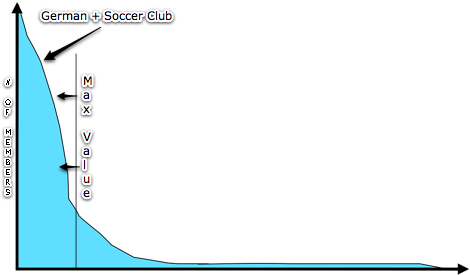In college, I tried to start an Entrepreneur Club but never got past the paperwork. The Student Activities office manager handed me three pages of clearly defined step-by-step guidelines she created on how to start a new group. It was evident she had spent a long time creating the document and was proud of the organization. The problem was I had no desire to go through three pages of steps. Lazy? Maybe. Normal behavior for most uninvolved students? Yes.
From the college’s perspective, there’s a cost associated with each new club and, under the current system, a college couldn’t handle a mass influx of clubs. Instead, colleges have to focus on the front end of the participation tail such as German and Soccer Club to maximize the participation versus output. In the current paradigm, it makes sense to try and squeeze out the maximum value and say that’s good enough, even if the current maximum value is only around 16 to 40 percent student participation.
Today there are many online tools that schools use to make the process more efficient. They do work and do speed up the process, but the problem remains that these tools keep us in the same paradigm as before. Student Activities continues to act as the gatekeeper in organizing anything or anyone on campus and there is still a cost to maintaining each new club.
In yesterday’s post**, Kevin said:
“The individual goal then, for education, is to provide every student with a group where they can be on the positive side of the hierarchy, increase their engagement and participation, and experience all of the positive mental effects of that status.”
My formation of an Entrepreneur Club was my attempt to get to the positive side of the hierarchy. I was part of much larger groups such as my major and graduation year, but, with both of these, I was on the lower end of the hierarchy. My school’s organizing system blocked me from participating unless I was highly motivated. This needs to change.
In Clay Shirky’s TED talk, “Institutions vs Collaboration,” he lays out the mathematics of participation and what it would take for an institution to allow anyone to participate. It gets good around 9:30 when he says:
“If your system is designed so that you have to give up a quarter of the value, re-engineer the system…Build the system so that anyone can contribute at any amount.”
It’s time for Student Activities to re-engineer its “gatekeeper” system and allow students to self-organize and participate, no matter how big or small. Not only will the increased participation cost the institution little to no extra resources, but it will also allow people like me to find the positive side of the hierarchy.
An example of this self-organization is WeFollow. WeFollow is an extremely simple tool for Twitter that allows users to build a directory of interests.
A user can input up to three tags to describe themselves. Each tag is then grouped together and users are ranked based on popularity. Anyone can look at any tag and see who’s in the group, how big is the group, and where they fit on the hierarchy of the group. Picking only three tags is a challenge, but reduces spam in the system and forces self-focus.
In thinking about adding myself to WeFollow, I had lots of tag options to pick from — Chicago, Education, Human, Male, Husband, etc… But, the broader the tag, the further I found myself down the list of hierarchy. So, I clarified my tags and choose “Speaker,” “Edtech” and “Peanut Butter.”
Speaker is the largest pool and I’m pretty far down the list. Edtech is a smaller pool than education, so I’m in the upper 1/3, but, with peanut butter, I’m right near the top, and, anyone who knows me personally, knows I love peanut butter! Granted the tag only has 3 people, but that’s the point.
I then connected with my fellow peanut butter lovers on Twitter and off we went. This connection or participation basically cost Twitter and WeFollow nothing, but increased participation in both. By re-engineering an older closed system directory, WeFollow allows anyone to participate, no matter how big or small.
This is not about Student Activities using new tools that make the old paradigm more efficient, it’s about Student Activities re-engineering itself to a new paradigm.

